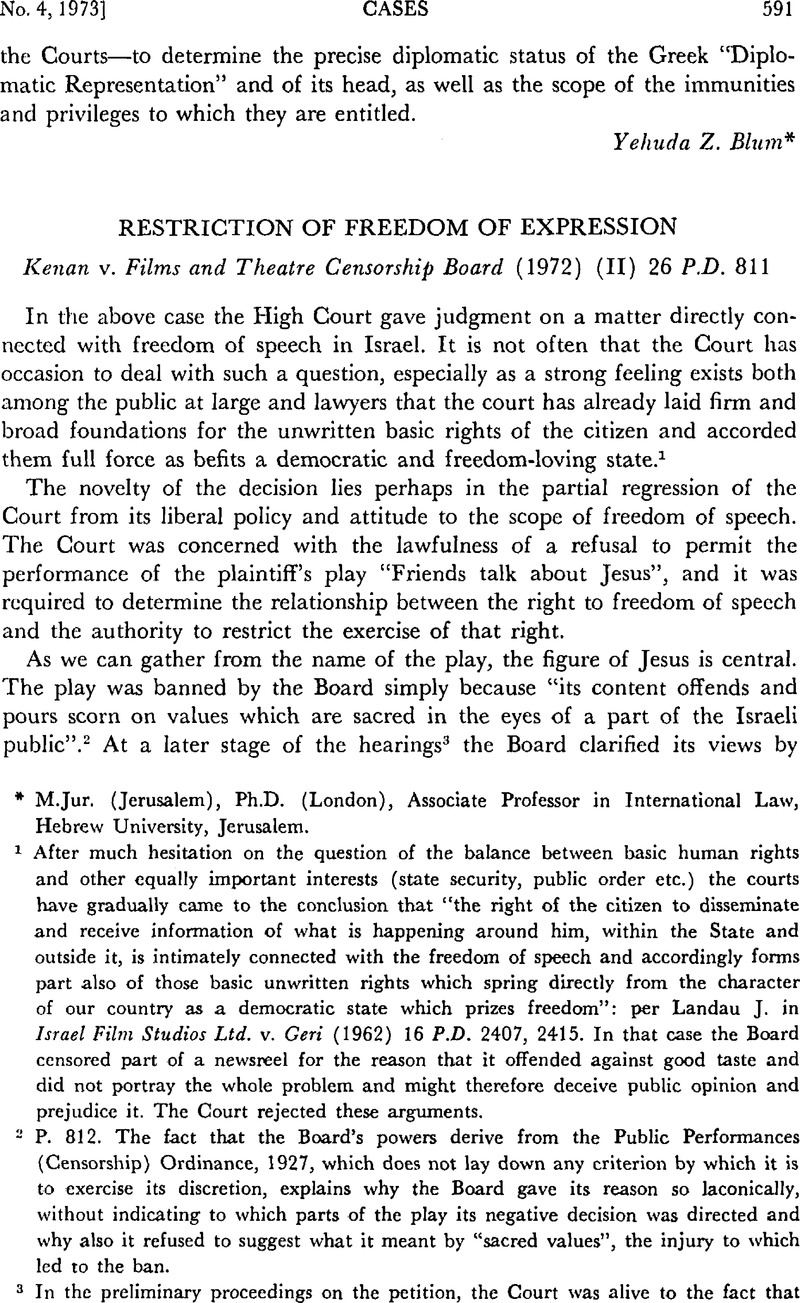No CrossRef data available.
Article contents
Restriction of Freedom of Expression
Published online by Cambridge University Press: 12 February 2016
Abstract

- Type
- Cases
- Information
- Copyright
- Copyright © Cambridge University Press and The Faculty of Law, The Hebrew University of Jerusalem 1973
References
1 After much hesitation on the question of the balance between basic human rights and other equally important interests (state security, public order etc.) the courts have gradually came to the conclusion that “the right of the citizen to disseminate and receive information of what is happening around him, within the State and outside it, is intimately connected with the freedom of speech and accordingly forms part also of those basic unwritten rights which spring directly from the character of our country as a democratic state which prizes freedom”: per Landau, J. in Israel Film Studios Ltd. v. Geri (1962) 16 P.D. 2407, 2415.Google Scholar In that case the Board censored part of a newsreel for the reason that it offended against good taste and did not portray the whole problem and might therefore deceive public opinion and prejudice it. The Court rejected these arguments.
2 P. 812. The fact that the Board's powers derive from the Public Performances (Censorship) Ordinance, 1927, which does not lay down any criterion by which it is to exercise its discretion, explains why the Board gave its reason so laconically, without indicating to which parts of the play its negative decision was directed and why also it refused to suggest what it meant by “sacred values”, the injury to which led to the ban.
3 In the preliminary proceedings on the petition, the Court was alive to the fact that the Board's decision as such did not give sufficient reason and that consequently it had to clear up two main points: a) what are the values sacred to a part of the Israeli public, which, in the Board's opinion the play offends; and b) which part of the public did the Board have in mind?
4 The Board actually pointed out in its answer that the play was liable to occasion outrage to the religious feelings of four groups of persons: a) those who possess religious sensitivity or faith in general; b) those in particular who are religious Christians; c) the majority of secular people who respect the religious feelings of others and recoil from disparaging them; d) those who believe in God and in the holiness of Jesus and Mary. The Board was also of the opinion that feelings of bereft parents were also affected, but it did not go into details. In any event, the Court did not refer specifically to these various possibilities, upholding the Board's decision on the sole ground that the play gave grave offence to the religious feelings of a part of the Israeli public, namely, religious Christians.
5 Sec. 149: “Any person who a) publishes any print, writing, picture or effigy calculated or tending to outrage the religious feelings or belief of other persons; b)…is guilty of a misdemeanour and is liable to imprisonment for one year”. This section, it may be observed—one of the exceptions to the basic rule prevailing in the Israeli legal system that a person is in no manner to be punished for his opinions or the expression thereof—applies not to the opinion itself but to the mode of its expression: Vagnen v. A.G. (1964) (I) 18 P.D. 29, 30.
6 This has been the view of the Supreme Court from the very beginning. See for instance: Kol Ha'am Company Ltd. v. Minuter of the Interior (1953) 7 P.D. 871, 879: “The right of freedom of speech is not an absolute and unrestricted right, but a relative right which may be limited and controlled in the light of the aim of important political and social interests which are considered in certain circumstances to have priority to those which are assured by giving effect to the principle of freedom of expression”; see also Vaguen v. A.G. ubi supra. Cf. Harnon, , “Free Speech in Matters which are Sub Judice” (1966) 1 Is. L.R. 151.Google Scholar
7 Per Etzioni J. at p. 816–7.
8 Forum Film Ltd. v. Films and Theatre Censorship Board (1961) 15 P.D. 611, 613.
9 Etzioni J. himself had said: “The term ‘public feelings’ is of wide meaning and the subject matter itself is a very sensitive one. It is not easy to determine what does and what does not wound public feelings. The question depends on the circumstances of the case and the entire context in which the matter arises”: Shemesh v. Companies Registrar (1971) (I) 25 P.D. 505, 516.
10 In Omar v. State of Israel (1970) (I) 24 P.D. 408, 413 the Court indeed had reservations about expert testimony, in this kind of case, regarding social or literary value. On the other hand, it held that it would be right to hear expert evidence on the scientific value of a publication.
11 “There can be no doubt that offence to the bereaved feelings of the individual and the whole public woven into the text of the play, evidences an insensitivity and vulgarity of which there is no equal” at p. 816.
12 Israel Films Studios Ltd. v. Geri, ubi supra at pp. 2407, 2416.
13 A simultaneous proposal to abolish film censorship was rejected.
14 In the language of the U.S. Supreme Court in A. Book etc. v. A.C. of Massachusetts (1966) 86A S.Ct. 975.
15 Obscene Publications Act, 1959, sec. 4. This approach was adopted by the District Court in A.G. v. Bar-Kochva Ben Moshe Levi (1961) 28 P.M. 16, 21.
16 Per Landau J. in Omar v. State of Israel (1970) (I) 24 P.D. 408, 411.


